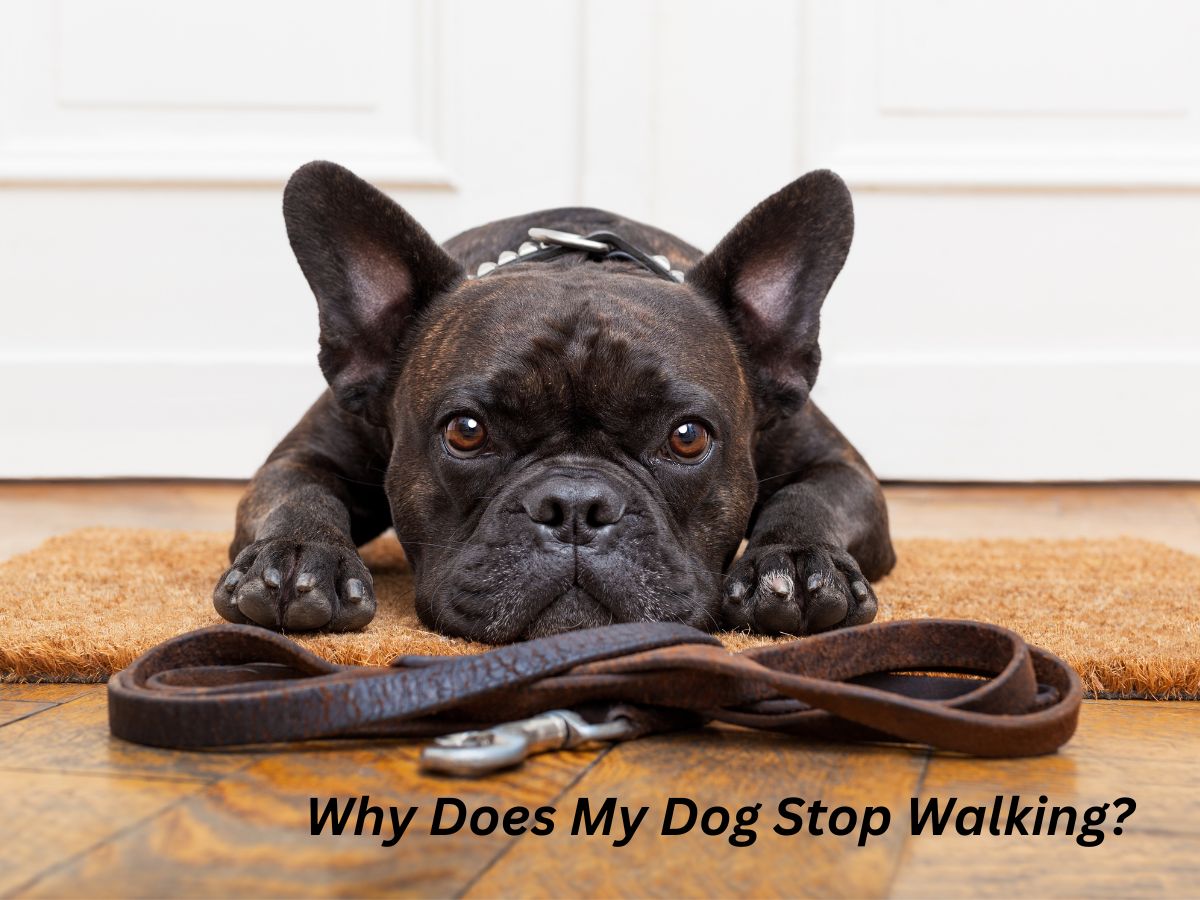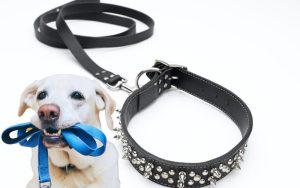Contents
- 1 Why does my dog stop walking? Understand reasons –
- 1.0.1
- 1.0.2 1.Injury or Pain
- 1.0.2.0.1 Why does your dog suddenly stop walking, it could be due to an injury or pain. Dogs can hurt their paws by stepping on sharp objects like glass or rocks. They might also strain a muscle or joint while running or jumping. If your dog starts limping or refuses to put weight on a leg, it could be a sign of injury.
- 1.0.2.0.2 Sometimes, even small cuts or bruises can make walking painful. Always check their paws for any cuts, swelling, or signs of discomfort. If you notice anything unusual, it’s best to take your dog to the vet for a proper check-up.
- 1.0.3
- 1.0.4 2.Tired or Overheated
- 1.0.4.0.1 Dogs may become fatigued or overheated, particularly during extended walks or warm days. Similar to humans, they require a break after expending a significant amount of energy. If your dog ceases moving, they could be either too fatigued to continue or overheated.
- 1.0.4.0.2 Showing signs of fatigue, reducing speed, or resting on the ground could indicate tiredness or overheating. Providing hydration and stopping for rest are crucial during walks. If the temperature is high, think about walking in the early morning or late evening when it is cooler outside.
- 1.0.5
- 1.0.6 3.Health Problems
- 1.0.6.0.1 Having health problems can also lead a dog to cease walking. Health issues such as arthritis, hip dysplasia, or other joint problems can cause discomfort while walking.
- 1.0.6.0.2 Elderly dogs are at higher risk of encountering these issues, although younger dogs can also suffer from health problems impacting their mobility. Heart or breathing issues could cause difficulty for your dog to walk extended distances without experiencing fatigue.
- 1.0.6.0.3 If your dog frequently pauses during walks and appears to have difficulty, it is recommended to seek a comprehensive evaluation from your veterinarian.
- 1.0.7
- 1.0.8 4.Age-Related Issues
- 1.0.8.0.1 As dogs get older, their energy diminishes, causing them to possibly have limitations in their walking distance compared to their youthful days. Elderly dogs can experience joint issues such as arthritis, leading to discomfort or pain while walking.
- 1.0.8.0.2 Their muscles may not possess the same strength and they might experience fatigue more quickly. Senior dogs often need shorter, slower walks to match their energy levels. If your older dog starts stopping frequently during walks, consider adjusting the length or intensity of your walks to suit their changing needs.
- 1.0.8.0.3
- 1.0.9
- 1.0.10 5.Discomfort from Collar or Leash
- 1.0.10.0.1 Why does my dog stop walking because their collar or leash is uncomfortable. If the collar is too tight or too loose, it can cause discomfort or even pain. A poorly fitted harness might restrict their movement, making them stop.
- 1.0.10.0.2 Some dogs are sensitive to the feeling of the leash pulling on their neck or chest. Always make sure your dog’s collar, leash, or harness fits properly and doesn’t cause any irritation. You can also try different types of gear to see what your dog is most comfortable with during walks.
- 1.0.11
- 1.0.12 6.Training or Behavioral Issues
- 1.0.12.0.1
- 1.0.12.0.2 Sometimes dogs stop walking because of training or behavioral issues. If your dog wasn’t properly trained to walk on a leash, they might pull or stop suddenly. They may also want to control the pace of the walk. Some dogs stop walking if they haven’t learned to follow commands like “heel” or “come.” If they’re distracted by something interesting, they may refuse to move.
- 1.0.12.0.3 It’s important to be consistent with training, using positive reinforcement to reward good behavior. Teaching your dog commands and practicing leash manners can help them walk more smoothly without stopping too often.
- 1.0.13
- 1.0.14 7.Not Interested in the Walk
- 1.0.14.0.1 Dogs, like people, have moods and preferences. Sometimes, your dog might just not be interested in walking. They may prefer staying home, playing with toys, or lounging around instead of going for a walk. If your dog seems uninterested, they may stop walking or turn around.
- 1.0.14.0.2 Try to make walks more fun by changing routes, adding some playtime, or offering treats along the way. Keep the walks enjoyable, and your dog will be more motivated to keep moving with you.
- 1.0.15
- 1.0.16 8.Fear or Anxiety
- 1.0.16.0.1 Fear or anxiety may lead to a halt in a dog’s movement. Loud sounds, new environments, or encountering other dogs can cause your dog to feel anxious. They could become motionless or immobilized if something frightens them. Certain dogs can be easily affected by unfamiliar surroundings and might become stressed while being taken for a walk.
- 1.0.16.0.2 Recognizing signs of fear is crucial, including shaking, tucking tail, or attempting to turn away. Slowly introduce your dog to unfamiliar circumstances in order to boost their self-assurance. Providing comfort and words of encouragement while walking can make them feel more secure and motivated to continue.
- 1.0.17
- 1.0.18 9.Hunger or Thirst
- 1.0.18.0.1 If your dog is hungry or thirsty, they may stop walking and refuse to continue. Just like humans, dogs need energy to walk and play.
- 1.0.18.0.2 If they haven’t eaten enough or had water before the walk, they might run out of energy quickly. Make sure your dog is well-fed and hydrated before taking them on a walk.
- 1.0.18.0.3 Bring water with you on longer walks, especially on hot days, to prevent dehydration. A snack before the walk can also help your dog stay energized and focused.
- 1.0.19
- 1.0.20 10.Uncomfortable
- 1.0.20.0.1 Your dog might stop walking if they feel uncomfortable. This unease may arise from warm pavement, chilly temperatures, or an object caught in their feet. Dogs may have sensitivities to the surface they are walking on. If the temperature is too high, they may decide to halt in order to prevent their paws from getting burned.
- 1.0.20.0.2 If it’s too cold, they may not want to continue. Always check the walking conditions before heading out and make sure your dog is comfortable.
- 1.0.20.0.3 Consider using booties to protect their paws in extreme weather or adjusting your walk time when the conditions are more suitable.
- 1.0.20.0.4
- 2 11– Helpful advice – to help your dog start walking:
- 2.1 1.Choose a Comfortable Leash and Collar
- 2.1.0.0.1 Make sure your dog’s leash and collar fit well. A good fit means the collar isn’t too tight or too loose. Choose a soft leash that’s easy for you to hold and doesn’t hurt your dog’s neck. You want your dog to feel safe and comfy while walking.
- 2.1.0.0.2 It’s important to pick gear that suits your dog’s size and breed, so they can enjoy the walk without any discomfort or fear. This will set the tone for positive walking experiences.
- 2.2
- 2.3 2.Let Them Sniff the Leash
- 2.3.0.0.1 Before the walk, let your dog smell the leash. This helps them get used to it and reduces any nervousness. Dogs use their sense of smell to understand new things, so sniffing the leash makes it feel familiar.
- 2.3.0.0.2 Spend some time showing the leash to your dog and allowing them to inspect it.
- 2.3.0.0.3 This step makes the leash seem less scary and more like something fun and normal, which can help them get ready for the walk.
- 2.4
- 2.5 3.Start Indoors
- 2.5.0.0.1 Begin walking your dog indoors where they feel safe. The inside of your house is familiar, so it’s a good place for practice. Walk slowly and let your dog explore while wearing the leash. Keep the leash short, but not too tight, to guide your dog gently.
- 2.5.0.0.2 By starting inside, your dog can learn the basics of walking without distractions like cars, people, or other dogs. This will build their confidence for when it’s time to go outside.
- 2.6
- 2.7 4.Give Treats for Good Behavior
- 2.7.0.0.1 Reward your dog with treats when they walk calmly beside you. This positive reinforcement teaches them that good behavior leads to rewards.
- 2.7.0.0.2 Keep treats handy, and every time your dog walks nicely without pulling, give them a small treat. This will encourage your dog to keep walking close to you and follow your lead. Make sure to praise them with a happy voice too, as dogs love hearing encouragement from their owners.
- 2.8
- 2.9 5.Keep Walks Short at First
- 2.9.0.0.1 For early walks, keep the duration short. New experiences can be overwhelming, so start with just a few minutes. As your dog gets more comfortable, you can slowly increase the length of the walks.
- 2.9.0.0.2 Short walks help build your dog’s stamina and give them time to adjust to the outside world. It also keeps the experience positive, preventing your dog from feeling tired or anxious. Patience is key, and with time, longer walks will become easier.
- 2.10
- 2.11 6.Stay Calm and Patient
- 2.11.0.0.1 When teaching your dog to walk, stay calm and patient. Dogs can sense your emotions, so if you’re relaxed, they will feel more at ease.
- 2.11.0.0.2 Rushing or getting frustrated can make your dog anxious, which might lead to pulling or refusing to walk. Take deep breaths, go slowly, and let your dog learn at their own pace. A calm approach helps build trust, making your dog more comfortable with walking and exploring their environment.
- 2.12
- 2.13 7.Use a Happy Voice
- 2.13.0.0.1 Encourage your dog by using a happy, upbeat voice during walks. Dogs respond well to friendly tones, and hearing your positive voice will make them feel safe and excited. Use cheerful praise when your dog walks nicely beside you, and offer gentle encouragement if they seem nervous.
- 2.13.0.0.2 Your happy voice can be a great motivator and help your dog associate walking with fun and rewards. It’s a simple but effective way to boost their confidence.
- 2.14
- 2.15 8.Walk in a Quiet Place
- 2.15.0.0.1 Start walking in a quiet place with few distractions. Busy streets, loud noises, or too many people can overwhelm your dog when they are just learning to walk. Instead, choose a calm area like a quiet park or a peaceful street.
- 2.15.0.0.2 This gives your dog a chance to focus on learning to walk without feeling stressed. As your dog becomes more confident, you can slowly introduce them to busier places.
- 2.16
- 2.17 9.Let Your Dog Explore
- 2.17.0.0.1 Let your dog sniff and explore while walking. Taking a walk serves as more than just physical activity for dogs; it also allows them to explore their surroundings and learn about the world.
- 2.17.0.0.2 Letting them sniff around makes the experience enjoyable for them. While keeping the leash loose, give your dog time to investigate their surroundings.
- 2.17.0.0.3 This will make the walk more interesting and help your dog feel more relaxed and happy. Exploring helps build positive associations with walking.
- 2.18
- 2.19 10.Walk at Their Pace
- 2.19.0.0.1 Allow your dog to determine the speed of the stroll. Certain dogs enjoy fast movement, whereas others favor a more leisurely tempo. Causing them stress can result from making them go either too fast or too slow. Be mindful of your dog’s pace and adapt to what they find comfortable.
- 2.19.0.0.2 Allowing your dog to walk at their own speed will reduce their anxiety and give them a sense of control. It is crucial to ensure that walks are a fun experience for your dog, not something they feel forced to participate in.
- 2.20
- 2.21 11.Practice Daily
- 2.21.0.0.1 Practice walking every day to help your dog get used to it. Short, daily walks help build confidence and improve their skills. Regular practice also helps your dog stay calm during walks and makes the experience a normal part of their routine. Even if it’s just for a few minutes each day, consistency is key.
- 2.21.0.0.2 Over time, your dog will become more comfortable, and walking will become easier and more enjoyable for both of you.
- 2.21.0.0.3
- 3 FAQs
- 4
- 5 Conclusion:
- 5.0.0.0.1 If your dog stops walking, it could be due to tiredness, fear, or discomfort. Pay attention to their body language and surroundings to understand the cause. Offering short, calm walks in quiet areas can help build their confidence.
- 5.0.0.0.2 Always use positive reinforcement, stay patient, and consult a vet if the behavior continues, as there may be health concerns. Patience and consistency will help your dog feel more comfortable over time.
If your dog is experiencing problems during walks, such as pulling on the leash, refusing to walk, or getting overly excited, here are some effective solutions to improve the walking experience:
Why does my dog stop walking? Understand reasons –
1.Injury or Pain
Why does your dog suddenly stop walking, it could be due to an injury or pain. Dogs can hurt their paws by stepping on sharp objects like glass or rocks. They might also strain a muscle or joint while running or jumping. If your dog starts limping or refuses to put weight on a leg, it could be a sign of injury.
Sometimes, even small cuts or bruises can make walking painful. Always check their paws for any cuts, swelling, or signs of discomfort. If you notice anything unusual, it’s best to take your dog to the vet for a proper check-up.
2.Tired or Overheated
Dogs may become fatigued or overheated, particularly during extended walks or warm days. Similar to humans, they require a break after expending a significant amount of energy. If your dog ceases moving, they could be either too fatigued to continue or overheated.
Showing signs of fatigue, reducing speed, or resting on the ground could indicate tiredness or overheating. Providing hydration and stopping for rest are crucial during walks. If the temperature is high, think about walking in the early morning or late evening when it is cooler outside.
3.Health Problems
Having health problems can also lead a dog to cease walking. Health issues such as arthritis, hip dysplasia, or other joint problems can cause discomfort while walking.
Elderly dogs are at higher risk of encountering these issues, although younger dogs can also suffer from health problems impacting their mobility. Heart or breathing issues could cause difficulty for your dog to walk extended distances without experiencing fatigue.
If your dog frequently pauses during walks and appears to have difficulty, it is recommended to seek a comprehensive evaluation from your veterinarian.
4.Age-Related Issues
As dogs get older, their energy diminishes, causing them to possibly have limitations in their walking distance compared to their youthful days. Elderly dogs can experience joint issues such as arthritis, leading to discomfort or pain while walking.
Their muscles may not possess the same strength and they might experience fatigue more quickly. Senior dogs often need shorter, slower walks to match their energy levels. If your older dog starts stopping frequently during walks, consider adjusting the length or intensity of your walks to suit their changing needs.
5.Discomfort from Collar or Leash
Why does my dog stop walking because their collar or leash is uncomfortable. If the collar is too tight or too loose, it can cause discomfort or even pain. A poorly fitted harness might restrict their movement, making them stop.
Some dogs are sensitive to the feeling of the leash pulling on their neck or chest. Always make sure your dog’s collar, leash, or harness fits properly and doesn’t cause any irritation. You can also try different types of gear to see what your dog is most comfortable with during walks.
6.Training or Behavioral Issues
Sometimes dogs stop walking because of training or behavioral issues. If your dog wasn’t properly trained to walk on a leash, they might pull or stop suddenly. They may also want to control the pace of the walk. Some dogs stop walking if they haven’t learned to follow commands like “heel” or “come.” If they’re distracted by something interesting, they may refuse to move.
It’s important to be consistent with training, using positive reinforcement to reward good behavior. Teaching your dog commands and practicing leash manners can help them walk more smoothly without stopping too often.
7.Not Interested in the Walk
Dogs, like people, have moods and preferences. Sometimes, your dog might just not be interested in walking. They may prefer staying home, playing with toys, or lounging around instead of going for a walk. If your dog seems uninterested, they may stop walking or turn around.
Try to make walks more fun by changing routes, adding some playtime, or offering treats along the way. Keep the walks enjoyable, and your dog will be more motivated to keep moving with you.
8.Fear or Anxiety
Fear or anxiety may lead to a halt in a dog’s movement. Loud sounds, new environments, or encountering other dogs can cause your dog to feel anxious. They could become motionless or immobilized if something frightens them. Certain dogs can be easily affected by unfamiliar surroundings and might become stressed while being taken for a walk.
Recognizing signs of fear is crucial, including shaking, tucking tail, or attempting to turn away. Slowly introduce your dog to unfamiliar circumstances in order to boost their self-assurance. Providing comfort and words of encouragement while walking can make them feel more secure and motivated to continue.
9.Hunger or Thirst
If your dog is hungry or thirsty, they may stop walking and refuse to continue. Just like humans, dogs need energy to walk and play.
If they haven’t eaten enough or had water before the walk, they might run out of energy quickly. Make sure your dog is well-fed and hydrated before taking them on a walk.
Bring water with you on longer walks, especially on hot days, to prevent dehydration. A snack before the walk can also help your dog stay energized and focused.
10.Uncomfortable
Your dog might stop walking if they feel uncomfortable. This unease may arise from warm pavement, chilly temperatures, or an object caught in their feet. Dogs may have sensitivities to the surface they are walking on. If the temperature is too high, they may decide to halt in order to prevent their paws from getting burned.
If it’s too cold, they may not want to continue. Always check the walking conditions before heading out and make sure your dog is comfortable.
Consider using booties to protect their paws in extreme weather or adjusting your walk time when the conditions are more suitable.
11– Helpful advice – to help your dog start walking:
Walking with your dog should be a fun and enjoyable experience for both of you. However, sometimes your dog may have trouble walking properly, whether they pull too much, stop suddenly, or refuse to walk at all. These issues can be frustrating, but with patience and the right techniques, you can help fix your dog’s walking problems. Here are some simple tips to help make walks smoother and more enjoyable.
1.Choose a Comfortable Leash and Collar
Make sure your dog’s leash and collar fit well. A good fit means the collar isn’t too tight or too loose. Choose a soft leash that’s easy for you to hold and doesn’t hurt your dog’s neck. You want your dog to feel safe and comfy while walking.
It’s important to pick gear that suits your dog’s size and breed, so they can enjoy the walk without any discomfort or fear. This will set the tone for positive walking experiences.
2.Let Them Sniff the Leash
Before the walk, let your dog smell the leash. This helps them get used to it and reduces any nervousness. Dogs use their sense of smell to understand new things, so sniffing the leash makes it feel familiar.
Spend some time showing the leash to your dog and allowing them to inspect it.
This step makes the leash seem less scary and more like something fun and normal, which can help them get ready for the walk.
3.Start Indoors
Begin walking your dog indoors where they feel safe. The inside of your house is familiar, so it’s a good place for practice. Walk slowly and let your dog explore while wearing the leash. Keep the leash short, but not too tight, to guide your dog gently.
By starting inside, your dog can learn the basics of walking without distractions like cars, people, or other dogs. This will build their confidence for when it’s time to go outside.
4.Give Treats for Good Behavior
Reward your dog with treats when they walk calmly beside you. This positive reinforcement teaches them that good behavior leads to rewards.
Keep treats handy, and every time your dog walks nicely without pulling, give them a small treat. This will encourage your dog to keep walking close to you and follow your lead. Make sure to praise them with a happy voice too, as dogs love hearing encouragement from their owners.
5.Keep Walks Short at First
For early walks, keep the duration short. New experiences can be overwhelming, so start with just a few minutes. As your dog gets more comfortable, you can slowly increase the length of the walks.
Short walks help build your dog’s stamina and give them time to adjust to the outside world. It also keeps the experience positive, preventing your dog from feeling tired or anxious. Patience is key, and with time, longer walks will become easier.
6.Stay Calm and Patient
When teaching your dog to walk, stay calm and patient. Dogs can sense your emotions, so if you’re relaxed, they will feel more at ease.
Rushing or getting frustrated can make your dog anxious, which might lead to pulling or refusing to walk. Take deep breaths, go slowly, and let your dog learn at their own pace. A calm approach helps build trust, making your dog more comfortable with walking and exploring their environment.
7.Use a Happy Voice
Encourage your dog by using a happy, upbeat voice during walks. Dogs respond well to friendly tones, and hearing your positive voice will make them feel safe and excited. Use cheerful praise when your dog walks nicely beside you, and offer gentle encouragement if they seem nervous.
Your happy voice can be a great motivator and help your dog associate walking with fun and rewards. It’s a simple but effective way to boost their confidence.
8.Walk in a Quiet Place
Start walking in a quiet place with few distractions. Busy streets, loud noises, or too many people can overwhelm your dog when they are just learning to walk. Instead, choose a calm area like a quiet park or a peaceful street.
This gives your dog a chance to focus on learning to walk without feeling stressed. As your dog becomes more confident, you can slowly introduce them to busier places.
9.Let Your Dog Explore
Let your dog sniff and explore while walking. Taking a walk serves as more than just physical activity for dogs; it also allows them to explore their surroundings and learn about the world.
Letting them sniff around makes the experience enjoyable for them. While keeping the leash loose, give your dog time to investigate their surroundings.
This will make the walk more interesting and help your dog feel more relaxed and happy. Exploring helps build positive associations with walking.
10.Walk at Their Pace
Allow your dog to determine the speed of the stroll. Certain dogs enjoy fast movement, whereas others favor a more leisurely tempo. Causing them stress can result from making them go either too fast or too slow. Be mindful of your dog’s pace and adapt to what they find comfortable.
Allowing your dog to walk at their own speed will reduce their anxiety and give them a sense of control. It is crucial to ensure that walks are a fun experience for your dog, not something they feel forced to participate in.
11.Practice Daily
Practice walking every day to help your dog get used to it. Short, daily walks help build confidence and improve their skills. Regular practice also helps your dog stay calm during walks and makes the experience a normal part of their routine. Even if it’s just for a few minutes each day, consistency is key.
Over time, your dog will become more comfortable, and walking will become easier and more enjoyable for both of you.
FAQs
1.Is my dog tired when they stop walking?
Yes, your dog might be tired. If they suddenly stop during walks, it could mean they need a rest. Try taking shorter walks and see if your dog walks better. Gradually increase the length as they get more comfortable.
2.Is my dog scared of something?
Your dog might be scared of noises, new places, or other animals. If they stop walking, check their surroundings for anything that could frighten them. Try walking in quieter areas until your dog feels more confident and comfortable on walks.
Conclusion:
If your dog stops walking, it could be due to tiredness, fear, or discomfort. Pay attention to their body language and surroundings to understand the cause. Offering short, calm walks in quiet areas can help build their confidence.
Always use positive reinforcement, stay patient, and consult a vet if the behavior continues, as there may be health concerns. Patience and consistency will help your dog feel more comfortable over time.




